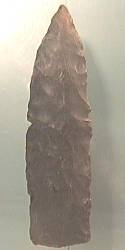Thomas (1981:18) defines the "Triple-T Concave Base" type as distinct from the Humboldt Series forms. This point is unshouldered with slightly to moderately concave base with distinctively rounded basal projections. These have rounder basal profiles than Humboldt Series points, and more gently curving sides. They are recorded at Gatecliff Shelter as dating c. 3400-3200 B.P., but Thomas notes possible affiliations with earlier pre-Mazama eruption specimens.
Holmer (1978:41-44) distinguishes between Humboldt Concave Base A and Concave Base B on the variable of length: Base A is longer than 3cm in length and Base B is shorter. Holmer (1986:101) notes that there are two primary periods of occurrence: Humboldt (Base A) points at c. 8000-6000 B.P. and Base B (McKean Lanceolate) points at c. 5000-3000 B.P.
Type Site: CH-15 (Heizer and Clewlow 1968).
Temporal Distribution: c. 7500-6000 B.P. (Eastern Great Basin); c. 6700-1200 B.P. (Western Great Basin); Early-Late Archaic.


